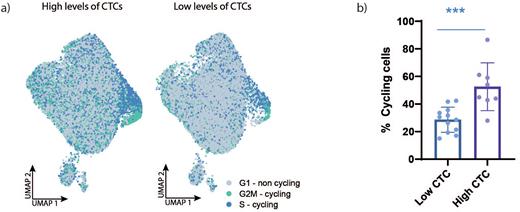Abstract
Introduction A subset of Multiple Myeloma (MM) patients responds poorly to treatment, highlighting the need to understand the pathobiology of high-risk MM. The correlation between aggressive disease and elevated levels of circulating tumor cells (CTCs) has been recognized. We recently identified a subset of high-risk newly diagnosed MM (NDMM) patients based on a transcriptomic classifier derived from patients with high levels of CTC, indicating that CTC levels are a relevant reflection of tumor cell biology. Here, we hypothesized that comparing bone marrow plasma cells (BM PCs) of MM patients with high and low CTC levels will provide an opportunity to identify mechanistic drivers of aggressive disease.
Results We first set out to exclude the presence of a circulating aggressive subclone of MM cells in patients with high levels of CTCs. Paired single cell transcriptomes from BM and peripheral blood MM cells of 7 NDMM patients were generated. Analysis of 55,230 CTCs and BM PCs revealed patient specific clustering, but with large transcriptional overlap between individual paired CTCs and BM PCs. Since only 11 genes were significantly upregulated in the BM PCs (P < 0.05) compared to paired CTCs, we excluded the presence of circulating aggressive subclones in patients with high CTC levels.
Next, we aimed to identify differences in MM cell pathobiology between patients with high and low levels of CTCs, we generated single cell transcriptomes from 89,092 BM MM cells from 8 NDMM patients with high (≥0.5%) and 14 patients with low (0.004-0.006%) percentages of CTCs. Single cell data integration across all patients led to the identification of 8 distinct PC clusters. Gene set enrichment analysis between both patient groups revealed upregulation of cell cycle pathways in MM cells of patients with high CTC levels. Based on cell cycle analyses an increase in cycling PCs (53% vs 32%, p=0.007) was associated with high CTC levels (Figure 1). Ki67 labeling of BM biopsies validated this finding. Interestingly, proliferation was increased across all transcriptomically-defined plasma cell clusters, suggesting a common cell-intrinsic driver of increased proliferation.
To analyze whether the prevalence of genetic lesions previously associated with proliferation was increased in patients with high CTC levels, WGS was performed on the same 22 patients. This revealed an elevated mutation burden and a predilection for MAF translocations, as 50% (4/8) of the patients with high CTC levels carried MAF translocations versus none in the patients with low CTC levels (0/14). We also observed increased transcription of cyclin D2 (CCND2), CCR1 and IntegrinB7 (ITGB7) in patients with high CTC levels. These proliferation or tumor survival genes have been shown to be increased in patients with t(14;16), a translocation also resulting in overexpression of MAF. To validate these findings in a larger patient cohort, clinical, genomic and CTC data were retrieved from the MMRF-CoMMpass database (n=725). Strikingly, 21% of patients with CTC levels above 0.3% showed MAF translocations vs only 3% in patients with CTC levels below 0.3% (p<0.001), solidifying the correlation between MAF translocations and high levels of CTCs in NDMM patients with a high-risk disease profile.
Conclusion Single cell RNA sequencing and WGS of MM cells from patients with high and low CTC levels identified a correlation between CTC levels and overrepresentation of MAF translocations in NDMM patients. This finding suggests that MAF target genes and downstream proliferation could be drivers of aggressive disease and might be used for future patient stratification.
Figure 1. Based on cell cycle analyses in single cell transcriptomics an increase in cycling PCs was associated with high CTC levels. a) UMAP of cell cycle analysis of 89,902 BM MM cells from 22 patients with high (n=8) and low (n=14) CTC levels. Colors represent cell cycle phase. b) Bar graph representing percentage of cycling cells. Data points are individual patients (high CTC levels, n=8; low CTC levels, n=14).
Disclosures
van der Velden:Cytognos: Other: laboratory services agreement ; Euroflow: Patents & Royalties; Agilent: Other: laboratory services agreement ; BD biosciences: Other: laboratory services agreement . Broijl:Bristol Myers Squibb: Other: Advisory boards/honoraria; Janssen: Other: Advisory boards/honoraria; Sanofi: Other: Advisory boards/honoraria; Amgen: Other: Advisory boards/honoraria. Sonneveld:Karyopharm: Membership on an entity's Board of Directors or advisory committees, Research Funding; Amgen: Membership on an entity's Board of Directors or advisory committees, Research Funding; Pfizer: Membership on an entity's Board of Directors or advisory committees; Bristol Myers Squibb: Membership on an entity's Board of Directors or advisory committees, Research Funding; Celgene: Membership on an entity's Board of Directors or advisory committees, Research Funding; Janssen: Membership on an entity's Board of Directors or advisory committees, Research Funding.
Author notes
Asterisk with author names denotes non-ASH members.


This feature is available to Subscribers Only
Sign In or Create an Account Close Modal